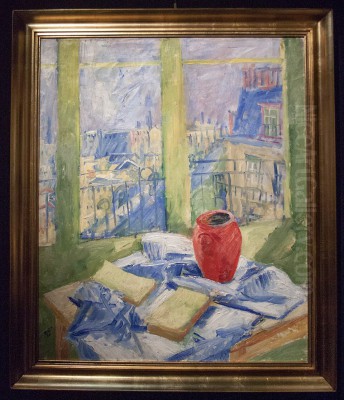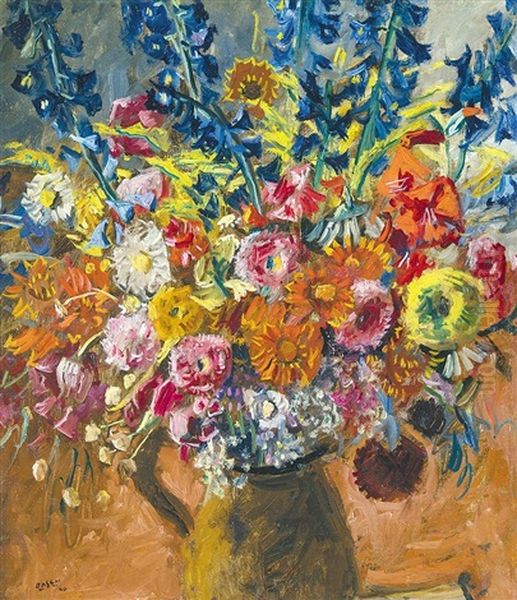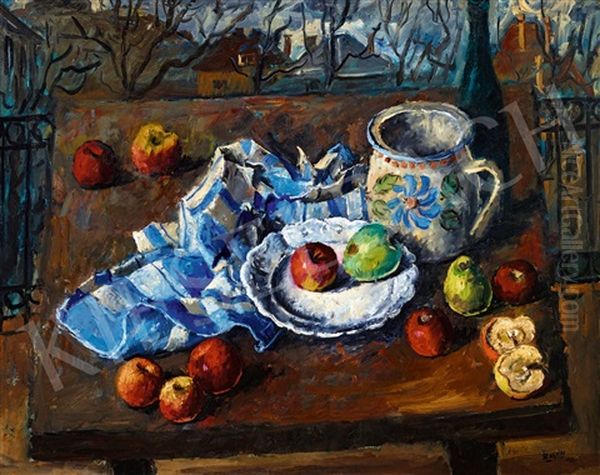
Andor Basch stands as a significant, albeit poignant, figure in early 20th-century Hungarian art. Born in Budapest in 1885 and tragically ending his own life in 1944, Basch navigated the complex artistic currents of his time, forging a distinctive style that synthesized the light-filled aesthetics of Impressionism with the structural rigour of academic training. His life and work reflect both the artistic dynamism and the devastating historical upheavals that shaped Hungary during his lifetime. As an artist, educator, and ultimately a victim of historical circumstance, his story offers valuable insights into the cultural landscape of Central Europe before and during the Second World War.
Early Life and Artistic Foundations
Andor Basch was born into an artistic milieu in Budapest, the capital of Hungary, which was then part of the Austro-Hungarian Empire. His father, Gyula Basch, was also a painter, providing an environment where artistic pursuits were likely encouraged from a young age. This familial connection to the art world undoubtedly played a role in shaping Andor's path. His formal artistic education began under the tutelage of Tivadar Zemplényi, a Hungarian painter known for his historical scenes and landscapes, often executed with academic precision but also showing sensitivity to light and atmosphere.
Zemplényi's instruction would have provided Basch with a solid grounding in traditional drawing and painting techniques. This foundational academic training remained a discernible element throughout Basch's career, even as he absorbed more modern influences. His early development occurred during a period when Hungarian art was actively seeking its own identity, looking towards both national traditions and the major art centres of Europe, particularly Paris.
Parisian Immersion: Academic Rigour and Modernist Encounters
Like many aspiring artists of his generation from across Europe, Basch sought further training and exposure in Paris, the undisputed centre of the art world at the turn of the 20th century. He enrolled at the prestigious Académie Julian, a private art school renowned for its high-level instruction and its international student body. The Académie Julian was a bastion of academic tradition, attracting students eager to master the skills necessary for success in the official Salons.

During his time in Paris, Basch studied for a year at the private school of Jean-Paul Laurens. Laurens was a highly respected painter and sculptor, known for his large-scale historical and religious paintings executed in a precise, academic style. Studying under Laurens would have reinforced Basch's skills in draughtsmanship, composition, and the traditional representation of the human form. This period provided him with a deep understanding of the academic principles that valued clarity, structure, and technical proficiency.
However, Paris was also a crucible of artistic innovation. Basch's time there coincided with the flourishing of Post-Impressionism and the explosive arrival of Fauvism. Significantly, Basch spent a year studying in the private school run by Henri Matisse between approximately 1908 and 1911. The Académie Matisse, though small and relatively short-lived, was an important hub for artists interested in exploring new directions in colour and form, directly under the guidance of one of modernism's leading figures.
Exposure to Matisse and the Fauvist circle, known for their radical use of non-naturalistic colour and expressive brushwork, must have presented a stark contrast to the academic training Basch received under Laurens. While Basch's mature style did not fully embrace Fauvist principles, the experience likely broadened his understanding of colour theory and encouraged a bolder approach to paint application than purely academic methods would have allowed. This period in Paris equipped Basch with a diverse set of tools and perspectives, blending traditional discipline with an awareness of avant-garde developments.
The Nagybánya Influence: Hungarian Modernism and Károly Ferenczy
Returning to Hungary, Basch became associated with another crucial centre of artistic development: the Nagybánya artists' colony (now Baia Mare, Romania). Founded in 1896 by Simon Hollósy and others, Nagybánya was pivotal in introducing plein-air painting and Impressionist and Post-Impressionist ideas into Hungarian art. It represented a move away from the constraints of studio-bound academicism towards a more direct engagement with nature and contemporary European styles.
Basch worked at Nagybánya intermittently, specifically between 1907 and 1910, and again in 1912. During these periods, he worked under the guidance of Károly Ferenczy, one of the leading figures of the Nagybánya school. Ferenczy himself had synthesized influences from French Naturalism, Impressionism, and Symbolism, developing a distinctive style characterized by harmonious colour, strong compositions, and a lyrical depiction of light and landscape. His influence on Basch was profound.

Working alongside Ferenczy and other Nagybánya artists like István Réti, János Thorma, and Béla Iványi-Grünwald exposed Basch to the colony's emphasis on capturing the effects of natural light and atmosphere. The Nagybánya school fostered a particular Hungarian interpretation of modernism, often blending Impressionistic techniques with a sense of structure and sometimes incorporating symbolic or decorative elements. Basch's time there was crucial in helping him integrate the lessons learned in Paris with the specific concerns and aesthetics of the Hungarian art scene. The experience solidified his commitment to landscape painting and portraiture informed by direct observation, yet composed with thoughtful structure.
Mature Artistic Style: A Synthesis of Influences
Andor Basch's mature artistic style is best understood as a personal synthesis of the diverse influences he absorbed throughout his training and career. He successfully navigated a path between the rigorous demands of academic tradition learned under Zemplényi and Laurens, and the liberating approaches to light, colour, and brushwork associated with Impressionism and Post-Impressionism, encountered in Paris and Nagybánya. His connection with Matisse also left a subtle trace, perhaps visible in his confident handling of paint and occasional boldness in colour choices, though he never adopted the radicalism of Fauvism.
His paintings often exhibit a strong sense of underlying structure and careful composition, hallmarks of his academic training. Figures are rendered with solidity, and architectural elements are depicted with attention to perspective and form. However, this structure is typically animated by a sensitivity to light and atmosphere reminiscent of Impressionism. He demonstrated a keen ability to capture the specific quality of light in a landscape or interior scene, using broken brushwork and a nuanced palette to convey mood and visual sensation.
Basch frequently turned his attention to the landscapes and cityscapes of his native Hungary, particularly Budapest and the scenic region around Lake Balaton. His depictions of Budapest often focus on its iconic bridges, buildings, and public spaces, rendered with both accuracy and atmospheric effect. Portraits and figure studies, including nudes, also formed an important part of his oeuvre. In these works, he combined psychological insight with a painterly approach, focusing on both the likeness of the sitter and the purely artistic qualities of form, colour, and texture. His style remained relatively consistent, evolving subtly rather than undergoing radical shifts, positioning him as a respected figure within the more moderate currents of Hungarian modernism, distinct from the more avant-garde experiments of groups like "The Eight" (Nyolcak), which included artists such as Róbert Berény, Béla Czóbel, Károly Kernstok, Ödön Márffy, and Lajos Tihanyi. Other major figures in Hungarian art during his active years included the influential Post-Impressionist József Rippl-Rónai.
Representative Works and Themes
Several key works illustrate Andor Basch's artistic concerns and stylistic characteristics. His Self-Portrait offers insight into how the artist viewed himself, likely rendered with the blend of realism and painterly handling typical of his work. Portraits were a significant genre for him, allowing for the exploration of character alongside formal artistic problems.
His landscapes and cityscapes are perhaps most representative of his synthesis. Budapest View with the Petőfi Statue and the Old Elizabeth Bridge exemplifies his interest in capturing the specific character of his native city. Such works often combine detailed observation of architectural landmarks with an impressionistic rendering of light, water, and sky, creating a poetic yet recognizable image of the urban environment. These paintings serve as valuable historical documents as well as artistic statements.
Works like Interior (1938) demonstrate his skill in handling indoor light and creating intimate, atmospheric scenes. The interplay of light and shadow, the rendering of textures, and the arrangement of objects within the space would showcase his compositional abilities and sensitivity to mood. Similarly, By Lake Balaton (painted in the 1920s) reflects his engagement with the Hungarian landscape, a recurring theme for many Nagybánya-influenced artists. Lake Balaton, with its distinctive light and expansive views, provided ample opportunity for exploring plein-air effects.
Figure studies such as Le Modèle (The Model), dated around 1925-1930, highlight his engagement with the nude, a traditional academic subject. In such works, Basch likely balanced anatomical accuracy and classical posing with a modern sensibility in terms of paint application and the treatment of form and colour. These paintings demonstrate his ability to work within established genres while infusing them with his personal style. Collectively, his works reveal an artist deeply engaged with his surroundings, capable of rendering both the external world and intimate scenes with technical skill and emotional resonance.
Career, Recognition, and Context
Andor Basch achieved considerable recognition during his career, both within Hungary and internationally. His participation in the first collective exhibition at the prestigious Ernst Museum in Budapest in 1919 marked an important step in establishing his reputation. The Ernst Museum was a key venue for modern Hungarian art, and exhibiting there placed him among the notable artists of his time.
His work gained international exposure through participation in exhibitions abroad. He showed his paintings in Amsterdam (1920), Helsinki and Stockholm (1922), and Paris and Zurich (1923). This international activity indicates that his art found resonance beyond Hungary's borders and was considered representative of contemporary Hungarian painting. Such exhibitions were crucial for cultural exchange and helped position Hungarian artists within the broader European art scene.
The acquisition of his works by the Hungarian National Gallery further solidified his status as an important national artist. Works held in the national collection, such as Interior (1938) and By Lake Balaton (1920s), ensure his continued visibility and contribution to Hungary's artistic heritage. His contemporary, Eduard Lammert (1867-1958), whose work Patakpart dates from 1912, provides another point of reference for the artistic environment in which Basch operated. Basch navigated a period of intense artistic debate in Hungary, finding his place between the established academic norms and the radical innovations of the avant-garde, contributing to the rich tapestry of Hungarian art in the early 20th century.
The Tragic End: Protest Against Tyranny
The final chapter of Andor Basch's life is marked by tragedy, inextricably linked to the catastrophic events of World War II. In March 1944, Nazi Germany occupied Hungary. This event ushered in a period of intensified persecution, particularly targeting Hungary's Jewish population, and brought the horrors of the war and the Holocaust directly onto Hungarian soil.
Faced with the brutality and barbarism of the Nazi occupation, Andor Basch made a devastating choice. In 1944, as German forces consolidated their control, he committed suicide. This act has been widely interpreted as a final, desperate protest against the Nazi regime and the atrocities being committed. It was a personal stand against the overwhelming tide of violence and oppression that was engulfing his country and Europe.
Basch's suicide underscores the profound impact of political and historical events on individual lives, particularly those of artists and intellectuals who are often deeply sensitive to the cultural and moral climate of their times. His death cut short a significant artistic career and silenced a voice that had contributed to the richness of Hungarian culture.
Following the war, his legacy was honoured. A memorial exhibition of his works was held at the Hungarian National Gallery, acknowledging his artistic achievements and commemorating his life and tragic end. This posthumous recognition ensured that his contributions would not be forgotten and highlighted the profound loss represented by his death, both personally and for Hungarian art. His final act remains a somber testament to the destructive power of totalitarianism and war.
Legacy and Conclusion
Andor Basch occupies a unique and respected place in the history of Hungarian art. His career spanned a period of significant transformation, and his work reflects a thoughtful engagement with the competing artistic ideas of his time. He skillfully blended the discipline and technical mastery of his academic training with the sensitivity to light, colour, and atmosphere championed by Impressionism and the Nagybánya school. While aware of more radical modernist trends, particularly through his time with Matisse, he forged a path that valued representation, harmony, and painterly quality.
His depictions of Budapest, Lake Balaton, and the Hungarian people contribute significantly to the visual record of the nation in the early 20th century. His ability to synthesize different artistic approaches resulted in a body of work characterized by its coherence, technical assurance, and quiet emotional depth. He was recognized during his lifetime through exhibitions both at home and abroad, and his works continue to be valued as part of Hungary's national artistic heritage, held in institutions like the Hungarian National Gallery.
The tragic circumstances of his death in 1944, a deliberate act of protest against Nazi tyranny, add a layer of profound poignancy to his life story. It serves as a stark reminder of the devastating human cost of war and persecution. Andor Basch is remembered not only for his artistic contributions—his beautifully rendered landscapes, insightful portraits, and atmospheric interiors—but also as an individual who, in the face of unbearable historical darkness, made the ultimate sacrifice. His legacy endures through his art, which continues to offer a window onto a specific time and place, filtered through a distinct and sensitive artistic vision.